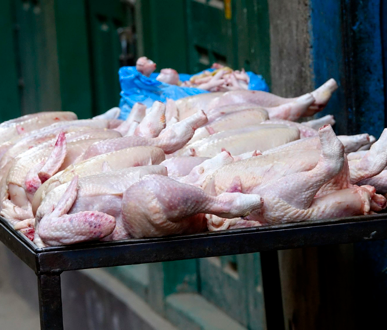
Many (as in many) food jokes have the line “tastes like chicken” in them somewhere. That is an indication of how ubiquitous this food stuff is.
As a creature, chickens are generally mistreated when they are farmed. The degree and types of torture that they endure is significant. This situation has developed because they tolerate the treatment fairly well (meaning they stay alive long enough to be harvested), it generally leads to more units of produced good per intake resource, and because the world’s appetite for chicken is significant.
Given the world-wide distribution of this food the ways and manners in which it is prepared for eating vary widely. All parts of the chicken are used for food stuffs.
Industrial production of chicken food has often led to serious contamination and disease issues. Large amounts of antibiotics are used in the production of chicken food (including eggs) and this has led to an increase in antibiotic resistant bacteria.
The photograph above was taken in a food stall in Kathmandu, Nepal.
Chicken is thought to have originated in either India or in Southeast Asia. Junglefowl, the ancestor of chicken are still found in those areas. From its point of origin, chicken has spread throughout the world (known from Egypt from about 1500 BCE, for instance).
Chicken is consumed directly (broilers) and chickens are kept for their egg production. The number of chickens currently in production ranges to about 20 billion worldwide.
Given their long period of domestication, there are many breeds of chicken, often sorted by whether they are intended to be layers or broilers. Note, however, that once layers stop producing eggs profusely they become meat.
In general, chicken meat has about twice as much protein as it does fat. It also contains significant levels of Vitamin A and Iron.
Most of the criticism leveled at chicken as a food source are aimed at the methods of production rather than the food stuff itself.